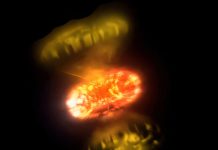
Where does gold really come from?
It turns out that the glittering metal on Earth has its roots in violent cosmic events — like exploding or colliding stars.
Scientists have long known that gold, platinum, and other heavy elements are made through a process called the rapid neutron-capture process (or r-process), but many details have remained mysterious.
Now, physicists from the University of Tennessee (UT) have made three major discoveries that bring us closer to understanding how the universe creates gold.
Their work, published in Physical Review Letters, could help improve models of how stars manufacture heavy elements and deepen our knowledge of exotic, short-lived nuclei.
When stars collapse or collide, they generate extreme conditions where atomic nuclei rapidly capture neutrons one after another.
These overloaded nuclei eventually become unstable and decay into lighter, stable atoms — the building blocks of precious metals like gold.
But since the nuclei involved in these reactions are unstable and short-lived, it’s almost impossible to study them directly. Scientists rely on models, which must be validated with rare experimental data.
To fill this gap, UT physicists, led by Professor Robert Grzywacz and his colleagues, teamed up with researchers at CERN’s ISOLDE facility in Switzerland.
Using advanced technology, they produced a large number of rare indium-134 atoms — a major challenge in itself.
These atoms decay into different forms of tin (tin-132, tin-133, and tin-134), allowing researchers to observe what happens when neutrons are released during decay.
With help from a special neutron detector built at UT, the team made three groundbreaking findings.
The first and most important was the first-ever measurement of neutron energies in a process called beta-delayed two-neutron emission. This phenomenon occurs only in exotic, unstable nuclei, where two neutrons are released almost simultaneously.
Measuring it was extremely difficult because neutrons are hard to track — they tend to bounce around, making it hard to tell how many were emitted.
“No one had measured energies before,” said Grzywacz. “This opens a completely new field.” This result helps scientists better understand how the r-process unfolds inside stars and how heavy elements like gold are born.
The second discovery involved finding a long-sought “single-particle neutron state” in tin-133, a key intermediate nucleus in the decay chain. Traditionally, scientists thought tin nuclei simply released neutrons randomly to cool down — losing all memory of how they formed.
But the UT team found that tin “remembers” its origin, behaving more predictably than expected. “Tin doesn’t forget,” said Grzywacz. This finding completes the picture of how the tin nucleus evolves and helps refine nuclear models used to simulate stellar element production.
The third discovery revealed that the decay process does not always behave statistically — meaning it doesn’t always follow predictable probability patterns. In most cases, decay processes are like “split-pea soup,” where everything mixes together.
But in this experiment, the process remained unusually clean and distinct, challenging long-standing theoretical assumptions. The results suggest that as scientists explore more exotic nuclei — even farther from the stable ones found on Earth — current models may fail, and new ones will be needed.
For graduate student and first author Peter Dyszel, who joined Grzywacz’s group in 2022, the project was both challenging and inspiring.
He helped design and assemble the detectors, managed the electronics, analyzed data, and interpreted results.
“The success of this work is due in part to my colleagues and collaborators,” he said. Together, their discoveries bring us one step closer to understanding the cosmic alchemy that transforms the chaos of exploding stars into the gold that shines on Earth.



